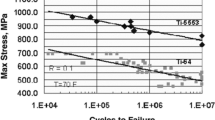Abstract
The high strength to density ratio of titanium alloys coupled with excellent corrosion resistance even at elevated temperatures make them ideal for aerospace applications. Moreover, the biocompatibility of titanium also enables its widespread use in the biomedical and food processing industries. However, the difficulty in machining titanium and its alloys along with the high cost of its extraction from ore form presents a major economic constraint. In the context of machining economics, the wear map approach is very useful in identifying the most suitable machining parameters over a feedrate–cutting velocity plane. To date, wear maps have only been prepared for the machining of ferrous alloys. In this article, a review of the machinability of Ti-6Al-4V alloy is presented with emphasis on comparing the wear performance of various tool materials. In addition, a new wear map for Ti-6Al-4V alloy is presented based on unified turning tests using H13A grade carbide inserts. This wear map can be used as a guide in the selection of cutting variables that ensure the least tool wear rates. This article contrasts the occurrence of a safety zone in the case of machining steels to that of an avoidance zone for Ti-6Al-4V alloy.
Similar content being viewed by others
References
Lutjering G, Williams JC (2003) Titanium. Springer-Verlag, Berlin
Duncan RM, Hanson BH (1980) The selection and use of titanium. Oxford University Press, Oxford
Hughes JI, Sharman ARC, Ridgway K (2006) The effect of cutting tool material and edge geometry on tool life and workpiece surface integrity. P I Mech Eng B–J Eng 220(B):93–107
Ezugwu EO, Wang ZM (1997) Titanium alloys and their machinability—a review. J Mater Process Technol 68:262–274
Lopez de lacalle IN, Perez J, Llorente JI, Sanchez JA (2000) Advanced cutting conditions for the milling of aeronautical alloys. J Mater Process Technol 100:1–11
Cherukuri R, Molian P (2003) Lathe turning of titanium using pulsed laser deposited, ultra-hard boride coatings of carbide inserts. Mach Sci Technol 7(1):119–135
Komanduri R, Von Turkovich BF (1981) New observations on the mechanism of chip formation when machining titanium alloys. Wear 69:179–188
Komanduri R, Reed WR Jr (1983) Evaluation of carbide grades and a new cutting geometry for machining titanium alloys. Wear 92:113–23
Ezugwu EO (2004) High speed machining of aero-engine alloys. J Braz Soc Mech Sci Eng XXVI(1):1–11
Jawaid A, Che-Haron CH, Abdullah A (1999) Tool wear characteristics in turning of titanium alloy Ti-6246. J Mater Process Technol 92–93:329–334
Ezugwu EO, Bonney J, Yamane Y (2003) An overview of the machinability of aeroengine alloys. J Mater Process Technol 134:233–253
Ezugwu EO, Da Silvaa RB, Bonney J, Machado AR (2005) Evaluation of the performance of CBN tools when turning Ti–6Al–4V alloy with high pressure coolant supplies. Int J Mach Tools Manuf 45:1009–1014
Zareena AR, Rahman M, Wong YS (2005) Binderless CBN tools, a breakthrough for machining titanium alloys. J Manuf Sci Eng 127:277–279
Fitzsimmons M, Sarin VK (2001) Development of CVD WC-Co coatings. Surf Coat Tech 137:158–163
Flom DG, Komanduri R, Lee M (1984) High speed machining of metals. Ann Rev Mater Sci 14:231–278
Schulz H, Moriwaki T (1992) High speed machining. Ann CIRP 41(2):637–643
Wang ZM, Rajurkar KP (2000) Cryogenic machining of hard-to-cut materials. Wear 239:168–175
Kishawy HA, Becze CE, McIntosh DG (2004) Tool performance and attainable surface quality during the machining of aerospace alloys using self-propelled rotary tools. J Mater Process Technol 152:266–271
Venugopal KA, Paul S, Chattopadhyay AB (2007) Growth of tool wear in turning of Ti-6Al-4V alloy under cryogenic cooling. Wear 262:1071–1078
Liao YS, Lin HM (2007) Mechanism of minimum quantity lubrication in high-speed milling of hardened steel. Int J Mach Tools Manuf 47:1660–1666
Walter JL, Skelly DW, Minnear WP (1993) Ion implantation of cobalt-tungsten carbide tools for machining titanium. Wear 170:79–92
Lim SC, Lee SH, Liu YB, Seah KHW (1993) Wear maps for uncoated high-speed steel cutting Tools. Wear 170(1):137–144
Lim SC, Lee SH, Liu YB, Seah KHW (1996) Wear maps for some uncoated cutting tools. Tribotest 3(1):67–88
Lim CYH, Lim SC, Lee KS (1999) Wear of TiC-coated carbide tools in dry turning. Wear 225–229:354–367
ISO (1993) ISO 3685-1993 (E) Tool-life testing with single-point turning tools. International Organization for Standardization, Geneva, Switzerland
Nouari M, Ginting A (2006) Wear characteristics and performance of multi-layer CVD-coated alloyed carbide tool in dry end milling of titanium alloy. Surface and Coatings Technology 200:5663–5676
Lim SC, Lim CYH (2001) Effective use of coated tools—the wear map approach. Surf Coat Tech 139:127–134
Author information
Authors and Affiliations
Corresponding author
Rights and permissions
About this article
Cite this article
Jaffery, S.I., Mativenga, P.T. Assessment of the machinability of Ti-6Al-4V alloy using the wear map approach. Int J Adv Manuf Technol 40, 687–696 (2009). https://doi.org/10.1007/s00170-008-1393-9
Received:
Accepted:
Published:
Issue Date:
DOI: https://doi.org/10.1007/s00170-008-1393-9




